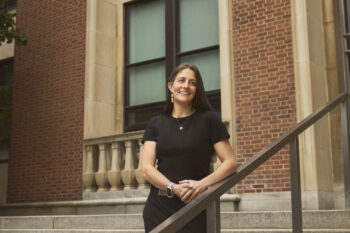A cannibalistic Mexican salamander that can regrow body parts it loses in fights may hold answers for researchers trying to unlock the power of stem cells to treat human disease, regenerative medicine pioneer Nadia Rosenthal told the inaugural Medicine by Design symposium this week.
“Everything develops, but not everything regenerates,” Rosenthal, scientific director at The Jackson Laboratory for Mammalian Genetics in Maine, said as she described the axolotl’s unusual abilities, which have attracted the attention of scientists seeking to understand the basic mechanisms of regeneration.
Rosenthal was among more than 250 engineering researchers, life scientists, computational biologists, doctors and students from across the University of Toronto and affiliated hospitals who gathered at the MaRS Discovery District on Nov. 28 to share research aimed at harnessing stem cells to treat conditions such as heart failure, cancer, liver disease and blindness. The event, which also attracted a number of international experts in the field and representatives from the government and private sector, celebrated the first year of Medicine by Design, an initiative funded by a historic grant from the federal government’s Canada First Research Excellence Fund that is driving stem cell research from foundational discovery to real-life application through innovative collaborations.
“We are contributing something new by converging people from diverse disciplines — mathematics, the physical sciences, engineering, biology and medicine — around the big questions in regenerative medicine,” said Peter Zandstra, executive director of Medicine by Design, Canada Research Chair in Stem Cell Bioengineering and a professor in the Institute of Biomaterials & Biomedical Engineering.
“It’s a really a very exciting time for regenerative medicine in Canada,” Zandstra added. “Medicine by Design, together with the Stem Cell Network, CCRM, the Ontario Institute for Regenerative Medicine and a number of emerging regional clusters throughout the country, really represent a comprehensive innovation hub that will strengthen Canada as a leader in this emerging biotechnology sector.”
Medicine by Design, which includes more than 90 principal investigators and hundreds of graduate students and postdoctoral fellows, builds on a rich legacy of U of T contributions to regenerative medicine, beginning with the demonstration of the existence of stem cells by biophysicist James Till and hematologist Ernest McCulloch in 1960. In its first round of collaborative team project awards, announced in August 2016, Medicine by Design awarded a total of $27 million to 20 teams across U of T and its hospital partners for projects that range from basic exploration of stem cell biology to technology development and clinical application. The initiative is also strengthening Toronto’s network of regenerative medicine researchers by recruiting emerging and established leaders in the field, and is working closely with CCRM to commercialize the breakthroughs that emerge from its research.
“With our hospital and commercialization partners, we are building a robust pipeline from research to clinical translation to commercialization, which is moving discoveries more quickly from the lab bench to the bedside and catalyzing innovative ideas and approaches that will help us attract and retain the best people in the field,” said Vivek Goel, U of T’s vice-president of research and innovation.



